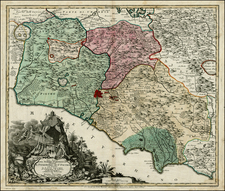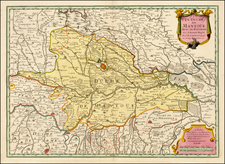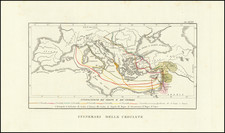The Third Bucentaur of Venice
Fine image of the bucentaur, the state barge of the Doge of Venice, making its annual trip to the Adriatic to perform the Marriage of the Sea", by the eminent cartographer Vincenzo Maria Coronelli.
The bucentaur or bucintoro in Italian and Venetian was the state barge of the doges of Venice. It was used every year on Ascension Day (Festa della Sensa) up to 1798 to take the doge out to the Adriatic Sea to perform the "Marriage of the Sea" – a ceremony that symbolically wedded Venice to the sea.
Scholars believe there were four major barges, the first significant bucentaur having been built in 1311. The last and most magnificent of the historic bucentaurs made its maiden voyage in 1729 in the reign of Doge Alvise III Sebastiano Mocenigo. Depicted in paintings by Canaletto and Francesco Guardi, the ship was 115 feet long and more than 26 feet high. A two-deck floating palace, its main salon had a seating capacity of 90. The doge's throne was in the stern, and the prow bore a figurehead representing Justice with sword and scales. The barge was propelled by 168 oarsmen, and another 40 sailors were required to man it.
In 1601 at the behest of the Doge Marino Grimani, the Venetian Senate decided to have a new (third) bucentaur. The designer of the new ship is unknown, but he was selected from among the most qualified marangoni (ships' carpenters) of the Venetian Arsenale. The work was supervised by Marco Antonio Memmo, the sovraprovveditore (overseer of the provveditore) of the Arsenale. The new vessel was approved and praised by all on its maiden voyage to the Lido with the newly elected Doge Leonardo Donato on Ascension Day, 10 May 1606.
The third barge was modelled after its predecessors, its decorations influenced by late-Renaissance forms. Contemporary illustrations show that the sides of the bucentaur were covered by mythical figures of sirens riding seahorses, and that the loggias were supported by curved dolphins amongst intertwined garlands and scrollwork taking on the form of monstrous hydras extending from the ends of the two bow spurs. It was once believed that most of the wooden sculptures, including a large sculpture of Mars, two lions of St. Mark positioned on either side of the stern, and the figurehead of Justice (dressed in apparel made by the San Daniele Monastery), were the work of the renowned Venetian sculptor Alessandro Vittoria, but research has revealed the names of the brothers Agostino and Marcantonio Vanini of Bassano who were praised as "authors of carvings of marvellous beauty" After more than a century of service, in 1719 a decision was made to demolish the ship.
Vincenzo Maria Coronelli (1650-1718) was one of the leading cartographers and globe-makers of the Baroque era. Born in Venice, he apprenticed as a xylographer, before joining the Franciscan order in 1665. Around 1678, after studying Astronomy, Coronelli began working as a geographer and was commissioned to make a set of Terrestrial and Celestial Globes for Ranuccio II Farnese, the Duke of Parma, which were 5 feet in diameter. Coronelli was next invited to Rome to construct a similar pair of Globes for Louis XIV. From 1681 to 1683, Coronelli lived in Paris, where he constructed a pair of 10 foot diameter globes for the King that weighed 4000 pounds. These spectacualr globes are today on display at the Bibliotheque nationale de France (Paris).
Coronelli then returned to Venice where he published his great atlas, the Atlante Veneto (1698) and founded the Accademia Cosmografica degli Argonauti, the world's first geographical society.
Vincenzo Maria Coronelli (1650-1718) was one of the most influential Italian mapmakers and was known especially for his globes and atlases. The son of a tailor, Vincenzo was apprenticed to a xylographer (a wood block engraver) at a young age. At fifteen he became a novice in a Franciscan monastery. At sixteen he published his first book, the first of 140 publications he would write in his lifetime. The order recognized his intellectual ability and saw him educated in Venice and Rome. He earned a doctorate in theology, but also studied astronomy. By the late 1670s, he was working on geography and was commissioned to create a set of globes for the Duke of Parma. These globes were five feet in diameter. The Parma globes led to Coronelli being named theologian to the Duke and receiving a bigger commission, this one from Louis XIV of France. Coronelli moved to Paris for two years to construct the King’s huge globes, which are 12.5 feet in diameter and weigh 2 tons.
The globes for the French King led to a craze for Coronelli’s work and he traveled Europe making globes for the ultra-elite. By 1705, he had returned to Venice. There, he founded the first geographical society, the Accademia Cosmografica degli Argonauti and was named Cosmographer of the Republic of Venice. He died in 1718.











![Constantinoplen en Egypten door Nicolaus Schmidt in enn zes Jarige Reystogt uyt Duytsland [shows Cyprus]](https://storage.googleapis.com/raremaps/img/small/57615.jpg)


![Marine, Vaisseau de Guerre avec toutes ses Manoeuvres et Cordages [Navy, Waship with all her Ropes and Riggings]](https://storage.googleapis.com/raremaps/img/small/88590.jpg)